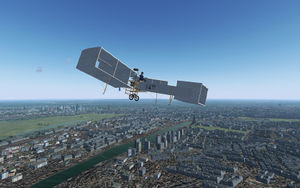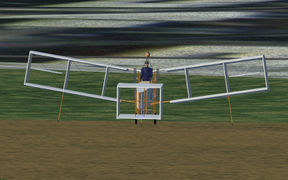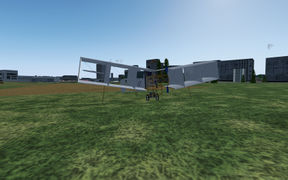Santos-Dumont 14-bis
 | |
|---|---|
 | |
| Type | Civil aircraft |
| Propulsion | Propeller aircraft, Single-engine aircraft |
| Manufacturer | Santos-Dumont |
| Author(s) | Emmanuel BARANGER (helijah) |
| FDM | YASim |
| --aircraft= | 14bis |
| Status | Alpha |
| FDM |
|
| Systems |
|
| Cockpit |
|
| Model |
|
| Development | |
| Website |
|
| Repository |
|
| Download |
|
| License | GPLv2+ |
| Wikipedia |
Santos-Dumont 14-bis |
|
| |
The 14-bis (Quatorze-bis), also known as Oiseau de proie ("bird of prey" in French), was a pioneer era canard biplane designed and built by Brazilian engineer Alberto Santos-Dumont.
History
On 23 October 1906, in Paris, France, it performed the first officially witnessed unaided takeoff and flight by a heavier-than-air aircraft. It was powered by an Antoinette V-8 engine with a 2-blade propeller and won a French aviation prize. Controversy exists between supporters of the Wright Brothers and Santos Dumont about which aircraft, the 14-bis or the 1903 Wright Flyer , was the first true airplane. The 1903 Wright Flyer used a launch rail and undercarriage skids. After 1903 the Wrights added a catapult to assist most takeoffs of their 1904 and 1905 airplanes. The Santos-Dumont 14-bis did not use a catapult and ran on wheels. The Fédération Aéronautique Internationale ("International Federation of Aeronautics"), founded in France in 1905 to "regulate the sport of flying", keeping track of aviation records and other aeronautical activities in the Western world, stated among its rules that an aircraft should be able to take off under its own power in order to qualify for a record. Therefore, some claim the 14-bis must be considered the first operational fixed-wing aircraft. Supporters of the Wright brothers emphasise that their aircraft made controlled, sustained, manoeuvring flights a few years before Santos Dumont made his first takeoff. What this means is that, if you really want to fly the first aircraft on FlightGear, you should try both the Wright Flyer and this plane.
Real-life Specifications
General characteristics
- Crew: one pilot
- Length: 9.70 m (31 ft 10 in)
- Wingspan: 11.20 m (36 ft 9 in)
- Height: 3.40 m (11 ft 2 in)
- Wing area: 52 m² (560 ft²)
- Loaded weight: 300 kg (661 lb)
- Powerplant: 1 × Antoinette 8V V-8 piston engine, 37 kW (50 hp)
- Performance
- Maximum speed: 40 km/h (25 mph/21 kts)
- Range: more than 220 m (720 ft)demonstrated
- Wing loading: 5.7 kg/m² (1.2 lb/ft²)
- Power/mass: 0.12 kW/kg (0.075 hp/lb)

